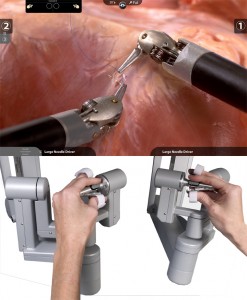
Robohub.org
Intuitive Surgical, a manufacturer with almost no tangible assets?
 Intuitive Surgical (NASDAQ:ISRG) is a prime example of how robotics is similar to other IP intensive industries like software, biotech, and entertainment.
Intuitive Surgical (NASDAQ:ISRG) is a prime example of how robotics is similar to other IP intensive industries like software, biotech, and entertainment.
In December my colleagues and I produced a valuation of Intuitive Surgical. Below is a representation of our model of the asset structure of Intuitive Surgical in our forecast. Whether you agree with our estimate of a 31% return on economic assets or not (though the stock market roughly seems to), this chart is very instructive to look at what the economic assets of a successful robotics firm are.
And hey, guess what?! Intuitive looks more like a software company than a traditional manufacturer. Strike another blow for the case that robotics companies – at least successful ones – are capital efficient!
Moreover, if I was critiquing the model in the valuation I would say that we hadn’t adequately valued the intangible assets of Intuitive Surgical. The intangible assets of the firm probably have a market value of 2-8 times what we estimate. Even with our conservatism, look at what you’re buying into when you buy a share of Intuitive: A $2Bn stack of cash, a multi-billion dollar IP portfolio, and a smallish medical device manufacturing company.

[How to read this chart: Black is our estimate of “R&D assets” in $K so starting balance is just shy of $2Bn. Red is GAAP non-financial assets, otherwise know as real stuff, like buildings, inventory, and accounts receivable. Grey is our estimate of financial assets with the current dividend policy–this model posits that Intuitive will be sitting on $4Bn in cash or the like in 2016 and an IP portfolio equally as large and valuable.Return on economic assets was estimated using our income forecast over capitalized R&D spending in the R&D account plus assets less cash and securities. The model has a depreciation factor for R&D each year to account for obsolescence and expiration. We went back several years to estimate an appropriate R&D account starting balance for the projection.]
The stock market assigns a $20Bn valuation to Intuitive. It recognizes that Intuitive’s control of intangible assets is very valuable. The graph of the model here only scratches the surface of intangible assets. We assumed that the only off balance sheet economic asset was an R&D account. Clearly, this is not the case as Intuitive Surgical also has unique and valuable organizational processes, sales relationships, and employment relationships with talented employees but those are much harder to find information about in SEC disclosures. Similarly, we also marked R&D at cost–with a portfolio as valuable as Intuitive’s the market is probably going to value the R&D output at more than Intuitive paid to develop the R&D assets.
Even with all this, Intuitive Surgical looks like lean, mean, capital efficient, IP intensive, knowledge economy company. Can anyone tell me why we let people talk about robotics like it is capital intensive?
I’d like to gratefully acknowledge my co-authors of this report who have given me permission to publish it: Avinash Belur, Naohiro Furuta, Masayuki Minato, Kohei Mutoh, & Dashampreet Sidhu. Analysis available by request.
tags: analysis, Intuitive Surgical




